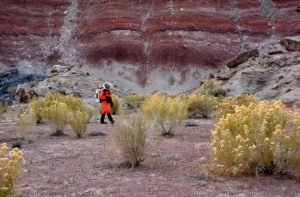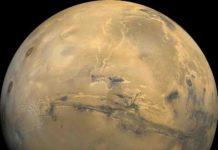
Future Martian explorers might not need to leave the Earth to prepare themselves for life on the Red Planet. The Mars Society have built an analogue research site in Utah, USA, which simulates the conditions on our neighbouring planet.
Practicing the methods needed to collect biological samples while wearing spacesuits, a team of Canadian scientists have studied the diverse local flora. Along with the lessons that one day will serve the first to conquer Mars, the researchers present an annotated checklist of the fungi, algae, cyanobacteria, lichens, and vascular plants from the station in their publication in the open-access journal Biodiversity Data Journal.
Located in the desert approximately 9 km outside of Hanksville, Utah, and about 10 km away from the Burpee Dinosaur Quarry, a recently described bone bed from the Jurassic Morrison Formation, the Mars Desert Research Station (MDRS) was constructed in 2002. Since then, it has been continuously visited by a wide range of researchers, including astrobiologists, soil scientists, journalists, engineers, and geologists.
Astrobiology, the study of the evolution and distribution of life throughout the universe, including the Earth, is a field increasingly represented at the MDRS. There, astrobiologists can take advantage of the extreme environment surrounding the station and seek life as if they were on Mars. To simulate the extraterrestrial conditions, the crew members even wear specially designed spacesuits so that they can practice standard field work activities with restricted vision and movement.
In their present research, the authors have identified and recorded 38 vascular plant species from 14 families, 13 lichen species from seven families, 6 algae taxa including both chlorophytes and cyanobacteria, and one fungal genus from the station and surrounding area. Living in such extreme environments, organisms such as fungi, lichens, algae, and cyanobacteria are of particular interest to astrobiologists as model systems in the search for life on Mars.
However, the authors note that there is still field work to be executed at the site, especially during the spring and the summer so that the complete local diversity of the area can be captured.
“While our present checklist is not an exhaustive inventory of the MDRS site,” they explain, “it can serve as a first-line reference for identifying vascular plants and lichens at the MDRS, and serves as a starting point for future floristic and ecological work at the station.”
Reference:
Paul Sokoloff, Colin Freebury, Paul Hamilton, Jeffery Saarela. The “Martian” flora: new collections of vascular plants, lichens, fungi, algae, and cyanobacteria from the Mars Desert Research Station, Utah. Biodiversity Data Journal, 2016; 4: e8176 DOI: 10.3897/BDJ.4.e8176
Note: The above post is reprinted from materials provided by Pensoft Publishers. The original story is licensed under a Creative Commons License.










